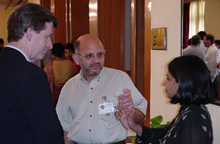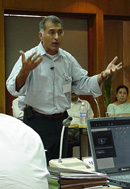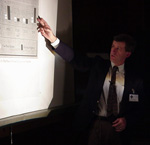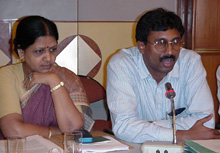|
|
|
 |
|
| Report on proceedings |
Some of the best brains
in the field of air quality management from across the world met in an international
workshop organised by Centre for Science and Environment in Delhi to develop two tools of
critical importance in air quality management. |
 |
The exercise of
developing methodologies for building two basic tools of air quality management for Delhi
an air quality index and an emission inventory was launched at an international workshop,
in the capital recently. The workshop was attended by experts from the US, Sweden, India,
Pakistan, Bangladesh and Nepal. The Indian participants included representatives from
Central Pollution Control Board (CPCB), Delhi Pollution Control Board (DPCC), National
Environmental Engineering Research Institute (NEERI), Indian Institute of Petroleum (IIP),
Automotive Research Association of India (ARAI) and Indian Institute of Technology (IIT),
Delhi. Three days of hard deliberations produced a blue print for future actions. |
|
 |
In 1997,
Centre for Science and Environment (CSE), New Delhi, had published a study which showed
that one person dies every hour in Delhi due to air pollution. But, despite the warning
and worsening air pollution levels, no action has yet been taken by the Government to
inform the public of the daily levels of pollution and how they affect their health. No
one can say anything with certainty about the sources of the deadly cocktail of pollutants
and how much of these pollutants these sources spew out in the air. In view of its
extended campaign for ‘Right to Clean Air’, CSE decided to take the initiative
to assess the ambient air quality through an AQI and the emission levels through an
emission inventory.
|
|
|
The Challenges
An AQI is used to inform the public of the daily air pollution levels and their effects on
the health of different groups of people like asthmatics, children, elderly and also to
healthy. However, developing an air quality index for Delhi presented unique problems. It
could not just adopt any model being used other countries.
The first step in developing an AQI is to identify the various problem pollutants and to
decide how to convey to the public the various effects the different levels pollutants
have on their health. But Delhi has the unique problem of a number of pollutants shooting
high above the permissible limit on any given day. The question that loomed large was how
to capture the health effects of the high levels of the mixture of these pollutants. |
|
Which pollutants
should be monitored?
Only three pollutants are monitored regularly at all sites in Delhi —sulphur dioxide,
nitrogen dioxide and suspended particulate matter. The experts, however, made it clear
that an AQI should be able to capture the health risk from pollution levels
comprehensively and for that the range of pollutants monitored be increased to include
pollutants like carbon monoxide, ozone and PM10. They also pointed out that the levels of
all pollutants should be reported to the public daily. |
|
What about toxic air
pollutants?
Another question, hotly debated during the discussions was whether to include toxic air
pollutants like benzene in the AQI. It is now well known that concentration of benzene, a
known carcinogen, in Delhi’s air is extremely high. However, the experts suggested
that a cancer risk map of Delhi should be prepared based on the annual average
concentration of benzene, rather than announcing its daily levels, as according to the
World Health Organisation there is no level below which it can be considered safe. |
|
AQI:
what and how much?
As the content of AQI notification is crucial to the success of the system, the question
that what message to convey to the public and how to categorise the air quality so that it
reflects adequately the level of air pollution in simplest terms emerged as a critical
issue. The experts explained that since protection of public health is the main aim of
developing an AQI, it should be able to clearly spell out which group of the population is
at risk from which pollutant. Arden Pope, Professor at Brigham Young University pointed
out that it is not enough to tell people whether the quality of the air they are breathing
is good or bad. According to him majority of the people affected by bad air do not
understand the health implications. Therefore it should be the primary aim of the AQI to
tell them about it. |
 |
|
Notably, the experts found
that if the AQI of USA, which has six descriptor categories, explaining the corresponding
health effects, is applied to the pollution levels of Delhi, most of the days will turn
out to be of unhealthy air quality, if not worse. Thus, they felt it is more important to
capture the health effects at various levels of pollution exceeding the permissible limit
rather than focussing on the levels below the limit. Therefore, they recommended that the
AQI should have 5 categories, of which 2 categories should be below and 3 above the
standards and that the descriptors to be used for these categories should be health-based
like good, unhealthy, very unhealthy and critical. |
|
What purpose will an
AQI serve?
However, besides serving advisory purpose for the public, the workshop also pointed out
that AQI could also serve as a tool for two major purposes. First, to educate people and
galvanise them in to action. Experience in Western countries has shown that once people
are made aware of the severity of the problem, they take up the initiative by putting
pressure on politicians and administrators to bring down the emissions and to make policy
level changes. Second, it can be used as a yardstick to declare pollution emergency.
Experts like Kirk Smith, Professor of Environmental Health Sciences at University of
California, Berkeley, and Shankar Prasad, Community Health Advisor to the Chairman of
California Air Resources Board, arguing strongly in favour of having pollution emergency
measures pointed out that emergency measures should be on two levels voluntary and
mandatory. However, the levels at which pollution emergency should be declared and what
the measures should be was left open to be discussed and developed.
But is an AQI enough to capture the risk air pollution poses to the health of people? Some
of the experts thought otherwise. Therefore, in addition to the AQI they came up with
another kind of index which can capture the long-term health effects of both criteria and
toxic air pollutants. To deal with these chronic effects, the group suggested to create a
Chronic Pollutants Index (CPI). |
|
Where do all these
pollutants come from?
But it is not enough only to know about the daily or monthly levels of pollution. For any
air pollution control policy to be effective it is absolutely essential to know where
these pollutants come from. This needs a detailed listing the various sources of air
pollution and the emissions from them in a given time frame, for instance, a month or a
year. This is what an emission inventory does. It is relatively easy to identify the
sources of pollutants, but the most important part is to know which source is contributing
how much of a particular pollutant. Only then can one formulate an action plan to control
the emission of that pollutant. |
|
What is the way
ahead?
During the discussions, it became clear that the whole exercise needed to be started from
scratch. But what does that mean in Delhi’s context? According to Linda Murchisson,
chief of the emission inventory branch, California Air Resources Board, preparing an
emission inventory is a step by step process.0 It involves identification of the sources
of pollution and the pollutants of concern, their distribution and trend in emission and
then identify and track if existing control policies are effective in controlling
pollution. |
|
 |
How to
develop an emission inventory?
There are well-established methods across the world to prepare an inventory. The US, which
started the air quality monitoring and inventorisation exercise from the 1970s, has
developed a system of tracking the changes in the rate of emissions from different sources
through photochemical modelling of air quality and trends. But that is not possible in the
Indian scenario without first putting a basic source apportionment exercise in place. The
European Union has developed a method using satellite imagery to identify land use
sectors. This information along with other data can be used to allocate emissions within a
geographic area. This method has been used extensively in Europe and is relatively
inexpensive. |
|
|
However, preparing such an
inventory for Delhi will be highly resource intensive. Therefore, the expert group felt
the best way would be to have two approaches — long-term and short-term. While the
short-term exercise will be to develop a preliminary inventory in one to two years’
time by way of doing rapid survey and using existing emission factors for calculating
emissions, the long-term exercise should be very detailed and can take 5 to 10 years.
In absence of credible emissions data for Delhi, it is not possible to use sophisticated
models currently being used in the US and Europe. Therefore, a comprehensive pollution
inventory exercise for Delhi has to begin with the conventional bottom-up approach, that
is survey and actual measurement of emissions. Without actually doing emissions
measurement from various sources, it is not possible to find out how much different
sources contribute to the total pollution load.
However, to help prioritise this exercise, satellite based emission estimates could be of
great help, the experts pointed out. Such an exercise, which is a short-term activity, has
the potential of pointing out the rate of emissions from different sources. |
|
| Attendees |
|
| Air Quality Index |
| 1. |
Joseph Cassmassi, Senior meteorologist, South Coast Air
Quality Management District |
| 2. |
Dr Shankar Prasad, Community Health Advisor to the Chairman
California air resources board |
| 3. |
Dr Arden Pope Professor, Department of Economics, Brigham
YoungUniversity |
| 4. |
Susan Lyon Stone, Environmental Health Scientist, Health and
Ecosystem Effects Group: US EPA |
| 5. |
Dr. Michael Kleinman, Professor, Air Pollution Health
Effects Laboratory, University of California |
| 6. |
James W. Yarbrough, U.S. Environmental Protection Agency |
| 7. |
Mr Edward L. Michel, Texas Natural Resource Conservation
Commission |
| 8. |
Mathew Abraham, Indian Institute o1.f Petroleum,
Dehradun. |
| 9. |
Dr B Sengupta, Member Secretary, C2.entral Pollution Control
Board |
| 10. |
Pawan Kumar, Scientist, EIA Division3., NEERI, Nehru Marg |
| 11. |
Dr Mukesh Sharma, IIT Kanpur 4. |
| 12. |
Prof. Kirk R Smith, Department of En5.vironmental Health
Sciences, University of California |
| 13. |
Promila Goyal, Centre for Atmospheri6.c Sciences, IIT Delhi |
| 14. |
K Srinivas, Automotive Research Ass7.ociation of India,
Emission Certification Laboratory |
|
|
| Emission Inventory and Air Quality
Monitoring |
| 1. |
Linda Murchisson Ph.D., Branch Chief, California Air
Resources Board, |
| 2. |
Michael Walsh , International Consultant, Arlington, USA |
| 3. |
Dr Viney P Aneja, Research Professor, Department of Marine
Earth and Atmosphere Sciences, North Carolina State University |
| 4. |
Peter Ahlvik, Ecotraffic, ERD AB, Sweden |
| 5. |
Eric Fujita Ph.D., Professor, Energy and Environmental
Engineering Centre, Desert Research Institute |
| 6. |
H B Mathur, Professor Emeritus, Delhi College of Engineering |
| 7. |
Åke Iverfeldt, IVL (Swedish Environmental Research
Institute Ltd.), Sweden |
| 8. |
Lennart Erlandsson, MTC AB, Department Air Quality –
Structural Projects, Sweden |
|
|
Why did
we do this workshop?
Despite advances in the scale and scope of urban air quality monitoring in recent years
major difficulties persists in getting comprehensive and reliable air quality data in the
Indian cities. Monitoring capability is so weak that routine information on all key
pollutants is not available to provide a reasonably complete picture of the air quality
trends and assess source wise trends in the city. There is need for a system that would
take comprehensive stock of air pollution in cities, warn people on a daily basis about
the risk, and set future targets for air quality with steady improvements over time. At
the moment we are unable to assess properly.
1. what are the serious and growing air pollutants in a city;
2. the contribution of different sources to these pollutants and whether or at what
speed these sources are growing; and
3. risk to public health from peak levels on a daily basis.
Nor can we develop pollutant wise action plans for each pollution source for an effective
impact. Therefore, the workshop will address the following: |
1.
Develop Air
Quality index for the city of Delhi
The public is not fully aware of the dangers that it faces on a regular basis. We would
like to develop an appropriate index that helps the public to know very clearly what are
the problems on a daily basis in a very simple way. As of now we are not sure what kind of
index would capture the risk from urban air pollution in a city like Delhi where a number
of gases are simultaneously going above the standards. A day when several gases are above
the standard is obviously going to be a particularly deadly day and the index should be
able to capture that. We would like to build into these indices toxicity indicators as
well so that the index should reflect not just the levels but also whether the cocktail of
air pollutants is less toxic or more. The toxicity of different air pollutants is
obviously different. Once we develop this index we would like to implement a smog alert
for the city in which apart from informing people on a daily basis about the air quality
in Delhi we would also put pressure on the government to implement pollution emergency
measures for an immediate local impact. |
|
3.
Develop
pollution inventory for the city of Delhi
We would also like to develop a good inventory of air pollution sources, so that source
wise contribution and trend in source wise emissions can be estimated and predicted as
also the health effects thereof. The weakest link in our air quality planning is that it
is still not possible to arrive at reliable source wise pollution load estimates in the
city. |
|
| This workshop brought together experts from all
over the world with interest and experience in these issues to help us develop
methodologies to develop air quality index and pollution source inventory for Delhi. |
|
|



